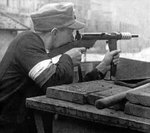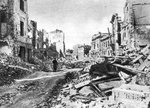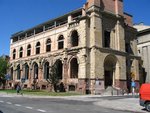Warsaw Uprising
|
|
Template:WarsawUprisingNav The Warsaw Uprising (Powstanie Warszawskie) was a controversial armed struggle during the Second World War by the Polish Home Army (Armia Krajowa) to liberate Warsaw from German occupation and Nazi rule. It started on August 1 1944, as a part of a nationwide uprising, Operation Tempest. The Polish troops resisted the German-led forces until October 2 (63 days in total). The losses on the Polish side amounted to 18,000 soldiers killed, 25,000 wounded and over 250,000 civilians killed, mostly in mass executions conducted by advancing German troops. Casualties on the German side amounted to over 17,000 soldiers killed and 9,000 wounded. During the urban guerilla combat—and after the end of hostilities, when German forces acting on Hitler's orders burned the city block after block—an estimated 85% of the city suffered destruction.
The Uprising started at a crucial point in the war as the Soviet army approached Warsaw. Although the Soviet army had reached a point within a few hundred metres of the city on September 16, the forces of the uprising and the advancing army never linked up. This failure and the reasons behind it have fed controversy ever since.
| Contents |
Eve of the battle
- Main article: Lead up to the Warsaw Uprising
- If not for Warsaw in the General Government, we wouldn't have 4/5 of our current problems on that territory. Warsaw was and will be the centre of chaos and a place from which opposition spreads throughout the rest of the country.
The Home Army's initial plans for a national uprising, Operation Tempest, which would link up with British forces, changed in 1943 when it became apparent that the Red Army would force the Germans from Poland. The discovery of the Katyn massacre occasioned the breaking-off of Polish-Soviet relations in April, and they never properly recovered. Although doubts existed about the military wisdom of a major uprising, the planning continued.
Flaga_PPP.png
The situation came to a head as Operation Bagration, the Soviet attack on Germany, reached the old Polish border on 13th July. At this point the Poles had to make a decision: either carry out the uprising in the current difficult political situation and risk problems with Soviet support, or fail to carry out an uprising and face Soviet propaganda describing Armia Krajowa as collaborators and ineffective cowards. The urgency of this decision increased as it became clear that after successful Polish-Soviet co-operation in the liberation of various towns (for example, in the Wilno Uprising), often the Soviet NKVD units who followed behind would either shoot or send to gulags most Polish officers and those Polish soldiers who could not or would not join the Soviet Army.
In the early summer of 1944, German planning required Warsaw to serve as the strong point of the area and to be held at all costs. The Germans had fortifications constructed and built up forces in the area. This process slowed after the failed July 20 Plot to assassinate Adolf Hitler, but by late July of 1944, the German forces had approximately reached their full strength again. On July 27, the governor of the General Government, Hans Frank, called for 100,000 Polish men between the ages of 17–65 to arrive at several concentration places in Warsaw the following day. The plan envisaged them constructing fortifications for the Wehrmacht in and around the city. The Home Army viewed this move as an attempt to neutralise the underground forces, and the underground urged Warsaw inhabitants to ignore it.
- More than 1,000 members of German Ordnungspolizei and Sicherheitspolizei have died in the course of their normal police duties; this does not include the losses during participation in any special operations. Alongside those losses, the number of 500 casualties among the various officials of all administration sectors deserves a separate mention – from the speech of Hans Frank on 18 November 1943
The official line of Soviet propaganda portrayed the Polish underground as "waiting with their arms at ease" and not fighting the common enemy. As the Soviet forces approached Warsaw in June and July 1944, the Soviet radio stations demanded a full national uprising in Warsaw to cut the communication lines of the German units still on the right bank of Vistula. On July 29, 1944, the first Soviet armoured units reached the outskirts of Warsaw.
On 25 July the Polish cabinet in London approved the planned uprising in Warsaw. Fearing German reprisal actions following the ignored order to support fortification construction and believing that time was of the essence, general Tadeusz Bór-Komorowski ordered full mobilisation of Home Army forces in the Warsaw area on August 1, 1944.
Opposing forces
- Main article: List of military units in the Warsaw Uprising
The Home Army forces of the Warsaw District numbered about 50,000 soldiers, 23,000 of them equipped and combat-ready. Most of them had trained for several years in partisan warfare and urban guerilla warfare, but lacked experience in prolonged daylight fighting. The forces lacked equipment, especially since the Home Army had shuttled weapons and men east of Warsaw before making the decision on 21 July to include Warsaw in Operation Tempest. Besides the Home Army itself a number of other partisan groups each subordinated themselves to Home Army command for the uprising. Finally, many volunteers, including some Jews freed from the concentration camp in the ruins of the Warsaw Ghetto, joined as the fighting continued.
General Antoni Chruściel, codename 'Monter', commanded the Polish forces in Warsaw. Initially he divided his forces into eight areas:
- Area I (Śródmieście, Old Town)
- Area II (Żoliborz, Marymont, Bielany)
- Area III (Wola)
- Area IV (Ochota)
- Area V (Mokotów)
- Area VI (Praga)
- Area VII (Powiat Warszawski)
- Zgrupowanie Kedywu Komendy Głównej
On September 20 a re-organisation of this structure took place to fit the structure of Polish forces fighting among the Western Allies. The entire force, renamed the Warsaw Home Army Corps (Warszawski Korpus Armii Krajowej) and commanded by General Antoni Chruściel (Monter), formed into three infantry divisions.
On August 1 their military materiel consisted of:
- 1,000 rifles
- 1,700 pistols
- 300 machine pistols
- 60 sub-machine guns
- 7 machine guns
- 35 anti-tank guns and carbines (including several PIATs)
- 25,000 hand grenades
In the course of the fighting the Poles obtained further gear through air drops and by capture from the enemy (including several armoured vehicles). Also, the insurgents’ workshops worked busily throughout the rising, producing during this period 300 automatic pistols, 150 flame-throwers, 40,000 grenades, a number of mortars and PIATs, and even an armoured car.
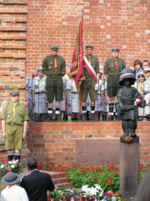
On August 1, 1944, the German garrison of Warsaw numbered some 10,000 troops under general Rainer Stahel. Together with various units on the left bank of the Vistula river the German forces comprised some 15,000 to 16,000 Wehrmacht soldiers as well as SS and police forces. However, the well-equipped German forces had been prepared for the defence of the city's key positions for many months. Several hundred concrete bunkers and barbed wire lines protected the buildings and areas occupied by the Germans. Also, at least 90,000 additional German troops occupied in the surrounding area. As of August 23, 1944, the German units directly involved with fighting in Warsaw included:
- Battle group Rohr (commanded by Major General Rohr)
- Battle group Reinefarth (commanded by SS-Gruppenführer Reinefarth)
- Attack group Dirlewanger
- Attack group Reck (commanded by Major Reck)
- Attack group Schmidt (commanded by Colonel Schmidt)
- various support and backup units
- Warsaw Garrison (Group of Warsaw Commandant) commanded by Lieutenant General Stahel
A large section of the personnel on the "German" side, according to Norman Davies (p. 284), came from "collaborationist forces", including Russians who had left in the Tsar's era and Azeris. All of these forces, however, remained clearly subject to the control of the German war machine.
The battle
- Main article: Military description of the Warsaw Uprising

The uprising began officially in daylight at 17:00 on "W-hour" August 1, a decision which is now regarded as a costly mistake. Although the Germans failed to realise that extra activity and early fights with the insurgents were linked and had not developed a plan for dealing with the uprising, they received warning, reportedly from a Polish woman, an hour before the start. Lack of surprise, sudden changes of plan, inexperience in day fighting and incomplete mobilisation meant that many of the early objectives of the uprising were not achieved. The first two days were crucial in establishing the battlefield for the rest of the uprising. Most successes were achieved in the city centre (Śródmieście) and old town (Stare Miasto) and nearby parts of Wola, where most objectives were captured, although major German strongholds remained. In other areas such as Mokotów the attackers almost completely failed to capture their objectives, while in areas such as Wola they captured most of their targets, but with very heavy losses that forced them to retreat. In Praga, on the East bank of the river, the German concentration was so high that the Polish forces fighting there were forced back into hiding. Most crucially, the fighters in different areas failed to link up, either with each other or with areas outside Warsaw, leaving each section of the city isolated from the others.
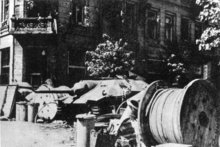
After the first several hours of fighting many units adopted a more defensive strategy while the civilian population started erecting barricades throughout the city. The moment of greatest success, on August 4, was also the moment at which the German army began receiving reinforcements. SS General Erich von dem Bach was appointed commander and soon after began to counter-attack with the aim of linking up with the remaining German pockets and then cutting off the Uprising from the Vistula (Wisla) river. August 5 is marked by the freeing of the former Warsaw Ghetto area by insurgents and by the beginning of the Wola Massacre, where in mass executions approximately 40,000 civilians were slaughtered by Germans. One aim of this policy was to crush the will to fight and put the uprising to an end without having to commit to the heavy city fighting; until late September, the Germans were shooting all captured insurgents on the spot for the same reason. In other areas, the prime aim of the German troops seems to have been to loot and rape rather than fight, which actually allowed defence to continue against the odds. This policy was later reversed when the German side decided that atrocities only stiffened the resistance. From the end of September on, some of the captured Polish soldiers were treated as POWs. On August 7 the German forces were joined by the tanks with civilians being used as human shields. After two days of heavy fights they managed to cut Wola in two and reach the Bankowy square.
| During the Uprising much of Długa street was reduced to ruins. The Bank Polski redoubt can be seen to be one of the few buildings in the street still standing in the 1944 photograph shown here on the left. The image on the right shows the bank still bearing the scars of the Uprising in 2004. | |
The aim was to gain a significant victory to show the Home Army the futility of further fighting and make them surrender. This did not succeed. Between August 9 and August 18 pitched battles raged around the old town and nearby Bankowy square, with successful attacks by the German side and counter-attacks from the Polish side. Once again, the German 'special' tactics were demonstrated by targeted attacks against marked hospitals. The Old Town was held until the end of August when lack of supplies made further defence impossible. On September 2 the defenders of the Old Town withdrew through the sewers, which at this time were becoming a major means of communication between different parts of the uprising. More than 5,300 men and women were evacuated in this way. German tactics very much hinged on bombardment through the use of huge cannons and bombers to which there could be very little answer from the Polish side.
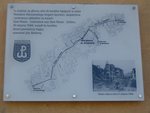
The Soviet army captured Eastern Warsaw and arrived on the Eastern bank of the Vistula in mid-September. When they finally reached the right bank of the Vistula on September 10, the officers of the Home Army units stationed there proposed recreating the pre-war 36th 'Academic Legion' infantry regiment; however, the NKVD arrested them all and sent them to Russia.
- Contrary to our expectations, the enemy has halted all of their offensive actions along the entire front of the 9th Army. – from the journal of German 9th Army on August 16 1944, showing the German amazement at the Russian response to the Uprising
Many of the "Soviets" who arrived in Poland were actually from the 1st Polish Army (1 Armia Wojska Polskiego), and some of them landed in the Czerniaków and Powiśle areas and made contacts with Home Army forces. With inadequate artillery and air support and coming in too small numbers, most were killed and they were soon forced to retreat. After repeated, almost unsupported attempts by the 1st Polish Army to link up with the insurgents failed, the Soviets limited their assistance to sporadic and insignificant artillery and air support. Plans for a river crossing were suspended "for at least 4 months", and the commander of the 1st Polish Army, General Zygmunt Berling, who ordered the crossing by his units, was relieved of his duties. From this point on, the Warsaw uprising can be seen as a one-sided war of attrition or, alternatively, as a fight for acceptable terms of surrender. Fighting ended on October 2 when the Polish forces capitulated.
Life behind the front lines
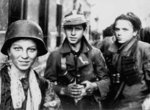
In the first weeks of the Uprising on Polish-controlled territory, people tried to recreate normal life in their free country. Cultural life was vibrant, with theatres, post offices, newspapers and similar activities. Polish Boy Scouts acted as a postal service risking their lives daily to transport any information that might help their people. Near the end of the Uprising, lack of food, medicine, overcrowding and obviously German indiscriminate air and artillery assault on the city made the civilian situation more and more desperate.
Lack of outside support
- Main article: Lack of outside support in the Warsaw Uprising
The limited landings by the 1st Polish army, mentioned above, represent the only outside soldiers who arrived to support the uprising. There was some other support in terms of airdrops from the Western allies, (the Royal Air Force and the Polish Air Force made 223 sorties and lost 34 aircraft), but the effect of these was very limited—in fact, mostly psychological, since all but one American supply drop had to be carried out using bases in Italy. The Soviets briefly (September 13–28) provided some air drops, without parachutes, but their most important action in this case was to deny landing rights for all other allied planes and to shoot down a number of those which carried supplies from Italy. American support was also limited. After Stalin's objections to support for the uprising, Churchill telegrammed Roosevelt on August 25 and proposed sending planes in defiance of Stalin and 'see what happens'. Roosevelt replied on August 26: I do not consider it advantageous to the long-range general war prospect for me to join you in the proposed message to Uncle Joe1.
The capitulation
- Main article: The capitulation of Warsaw after the Warsaw Uprising.
Ac.bor-bach.jpg
On October 2 General Tadeusz Bór-Komorowski signed the capitulation of the remaining Polish forces (Warszawski Korpus Armii Krajowej or Home Army Warsaw Corps) in the German headquarters in the presence of General von dem Bach. According to the capitulation agreement the Wehrmacht promised to treat Home Army soldiers in accordance with the Geneva Convention, and to treat the civilian population humanely.
- One of the most deadly fights since the beginning of the war, as difficult as the fight for Stalingrad – Heinrich Himmler to other German generals on 21 September 1944
The next day the Germans begun to disarm the Home Army soldiers. They later sent most of them to POW camps in various part of Germany. At the same time they resettled the civilian population (approximately 700,000) in concentration camps west of Warsaw. Many soldiers, fearing German atrocities in captivity, chose to blend into the civilian population, escape Warsaw among them and continue the fight later.
The Warsaw uprising failed because it did not manage to link up with the Soviet forces just a short distance away. The reason for this failure now appears as Soviet reluctance to act when the possibility existed, but the reasons for this failure to act, whether political failure on the Polish side or malice on the Soviet side, remain a matter of ongoing debate.
Destruction of the city
After the remaining population had been expelled, the Germans started the destruction of the remnants of the city. Special groups of German engineers were dispatched to the city in order to burn and demolish the remaining buildings. According to German plans, after the war Warsaw was to be turned into a lake. The demolition squads used flame-throwers and explosives to methodically destroy house after house. They paid special attention to historical monuments and places of interest: nothing was to be left of what used to be a city. By January 1945 85% of the buildings were destroyed: 25% as a result of the Uprising, 35% as a result of systematic German actions after the uprising, the rest as a result of the earlier Warsaw Ghetto Uprising (15%) and other combat including the September 1939 campaign (10%). Material losses were estimated at 10,455 buildings, 923 historical buildings (94 percent), 25 churches, 14 libraries including the National Library, 81 primary schools, 64 high schools, Warsaw University and Warsaw University of Technology, and most of the historical monuments. Almost a million inhabitants lost all of their possessions. The exact amount of losses of private and public property as well as pieces of art, monuments of science and culture is unknown. However, various estimates place it at an equivalent of approximately 40 billion 1939 US dollars. In 2004 the Warsaw self-government authorities estimated that the approximate loss of the municipal property is 45 billion 2004 US dollars (this includes only the property owned by the city of Warsaw on August 31, 1939). The municipal council of Warsaw is currently disputing whether claims for German reparations should be made.
"Liberation" of the ruins
After several months of watching the city die, the Red Army finally crossed the river on January 17, 1945. They captured the ruins of Festung Warschau in a few hours, with little or no opposition from the Germans. German units put up some minor resistance in the Warsaw University area, but Soviet forces broke the German defences in less than an hour.
The legacy
- Main article: After effects of the Warsaw Uprising
Uprising_Grob.png
Due to lack of cooperation and often the active aggressive moves on the part of the Soviets and several other factors, the Warsaw Uprising and Operation Tempest failed in their primary goal: to free part of the Polish territories so that a government loyal to the Polish government-in-exile could be established there instead of a Soviet puppet state. There is no consensus among historians as to whether that was ever possible, or whether those operations had any other lasting effect. Some argue that without Operation Tempest and the Warsaw Uprising, Poland would have ended as a Soviet republic, a fate definitely worse than that of an "independent" puppet state, and thus the Operation succeeded at least partially in being a political demonstration to the Soviets and Western Allies. It is also worth mentioning that due to the Warsaw Uprising, the Soviets stopped their offensive in Poland to let the Germans suppress the uprising. Some historians speculate that if they hadn't done so, they would have occupied all Germany rather than the eastern part only.
Estimates of casualties range between 180,000 and 250,000, with an average of 220,000 often cited; more importantly, many of those lost were the people who would have been important for recovery (although many of the Polish intelligentsia had already been killed at the time of the Soviet and German invasions in 1939). The city of Warsaw was rebuilt, with the old town being restored to its former state. However, complete recovery as a major European capital only began in the early 1990s after the fall of communism.
After the war
Most soldiers of the Home Army (including those who took part in the Warsaw Uprising) were persecuted after the war: captured by the NKVD or UB, interrogated and imprisoned, awaiting trials on various charges. Many of them were sent to gulags or executed. Most of those sent to POW camps in Germany were later liberated by British, American and Polish forces and stayed in the West, including uprising leaders Tadeusz Bór-Komorowski and Antoni Chruściel, who stayed in London and the United States, respectively.
Knowledge of the Warsaw Uprising, inconvenient to Stalin, was twisted by propaganda of the People's Republic of Poland, which stressed the failings of Home Army and the Polish government-in-exile, and forbade all criticism of the Red Army or the political goals of Soviet strategy. Until the late sixties the very name of the Home Army was censored, and most films and novels covering the 1944 Uprising were either banned or modified so that the name of the Home Army did not appear there. Also, the official propaganda of both Poland and the USSR suggested that the Home Army was some sort of a group of right-wing collaborators with Nazi Germany. From 1956 on, the image of the Warsaw Uprising in Polish propaganda was changed a little bit to underline that the soldiers were indeed brave, while the officers were treacherous and the commanders were characterised by disregard of the losses. The first serious publications on the topic were not issued until the late eighties. In Warsaw no monument to the Home Army could be built until 1989. Instead, efforts of the Soviet-backed Armia Ludowa were glorified and exaggerated.
In the West, the story of the Polish fight for Warsaw with little support was an embarrassment, as was the shock of Home Army soldiers as Western Allies recognised the Soviet controlled pro-Communist regime installed by Stalin; as a result, the story was not publicised for many years.
The courage of the Warsaw Uprising, and its betrayal by the Soviet Union, contributed to keeping anti-Soviet sentiment in Poland at a high level throughout the Cold War. Memories of the uprising helped to inspire the Polish labour movement Solidarity, which led an opposition movement against the Communist government during the 1980s, leading to the downfall of that government in 1989 and the emergence of democracy.
After 1989 censorship of the facts of the Uprising ceased, and 1 August has now become a celebrated anniversary. In 1 August 1994, Poland had a ceremony commemorating the 50th anniversary of the Uprising. Germany and Russia were invited to the ceremony, although there was opposition to Russia's invitation. Moreover, "a joke making the rounds suggests that Yeltsin should be given a pair of binoculars so he can observe the ceremony from across the [Vistula] river." On July 31, 2004, a Warsaw Uprising Museum opened in Warsaw (see "Related links" below for recent news reports on this event).
References
The following sources have been used in preparing this article.
Book sources
- Norman Davies. Rising '44: The Battle for Warsaw<cite>. Viking Books, 2004. ISBN 0670032840. Hardcover, 784 pages.
- Template:Book reference
- Władysław Bartoszewski. <cite>Dni walczącej stolicy<cite>. Świat Książki, Muzeum Powstania Warszawskiego, Warsaw, 2004. ISBN 8373916792. Hardcover, 522 pages.
- Tadeusz Bór-Komorowski. <cite>Secret Army<cite>. Macmillan Company, New York 1951. ISBN 0898390826. Hardcover, 407 pages.
- Jan Karski. <cite>Story of a Secret State<cite>. Simon Publications, 2001. ISBN 1931541396. Paperback, 391 pages.
- See also this external link (http://www.polishresistance-ak.org/FurtherR.htm) for more English language books on the topic.
- "Old scars, new squabbles." Newsweek, 1 Aug 1994.
Note
- See Warsaw Uprising CNN Special (http://www.cnn.com/CNN/Programs/presents/shows/warsaw.rising/interactive/timeline.warsaw/frameset.exclude.html) external link for quote reference
See also
- Warsaw Ghetto Uprising - sometimes the name Warsaw Uprising is mistakenly attributed to this earlier struggle of Jews in the Ghetto in 1943.
- Home Army
- Operation Tempest
- Polish contribution to World War II
- kotwica
- Western betrayal
External links
- Warsaw Uprising Museum in Warsaw (http://www.1944.pl)
- Warsaw Uprising 1944 (http://www.warsawuprising.com) A source for checking data used in this page and offers of material and help.
- the Warsaw uprising (http://www.polishresistance-ak.org/4%20Article.htm) on the Polish Resistance (http://www.polishresistance-ak.org/) page provides information and maps which may be freely copied with attribution.
- Warsaw Rising: The Forgotten Soldiers of World War II. Educator Guide (http://cnnstudentnews.cnn.com/2004/fyi/news/06/03/cnnpce.warsaw.rising)
- Extensive information on Warsaw Uprising (http://www.whatfor.prv.pl/) (in Polish)
- Photographs of the Warsaw Uprising (http://www.ipn.gov.pl/aktual_powst_war.html)
- The Warsaw Rising (http://www.polandinexile.com/rising.htm)
- The Warsaw Uprising - 1.VIII.1944 (http://wings.buffalo.edu/info-poland/exhib/warsaw/index.html)
- Dariusz Baliszewski, Przerwać tę rzeź! Tygodnik "Wprost", Nr 1132 (08 August 2004) (http://www.wprost.pl/ar/?O=64298)
- Polish Boy Scouts Deliver "AK" Mail (http://www.sossi.org/local/warsaw.htm)
- Warsaw Uprising CNN Special (http://www.cnn.com/CNN/Programs/presents/shows/warsaw.rising/interactive/timeline.warsaw/frameset.exclude.html)bg:Варшавско въстание
cs:Varšavské povstání de:Warschauer Aufstand fr:Insurrection de Varsovie ia:Insurrection de Varsovia he:מרד ורשה ja:ワルシャワ蜂起 pl:Powstanie warszawskie pt:Revolta de Varsóvia fi:Varsovan kansannousu zh:華沙起義

